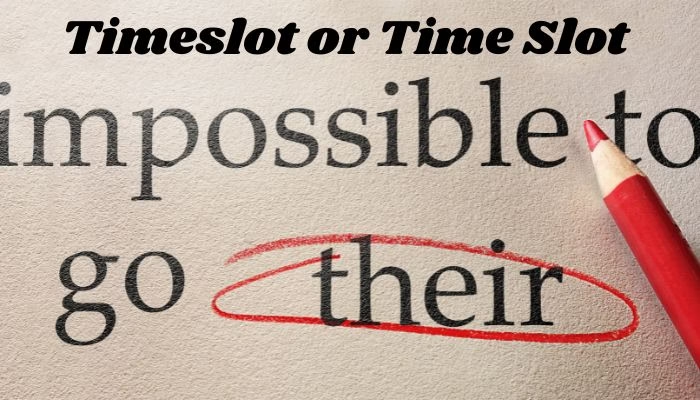For anyone who writes professionally—whether you’re a content writer, blogger, or an English enthusiast—you’ve probably encountered the question: is it “timeslot” or “time slot”? It’s a common point of confusion, especially as language usage evolves over time (and through different regions).
Understanding the correct spelling and grammatical context is critical for producing polished and professional content. With “timeslot” and “time slot” being used interchangeably in everyday language, this blog will break down their definitions, common usages, and when to use one or the other based on grammatical rules and context.
By the end of this post, you’ll be able to confidently decide which version to use in your writing, ensuring accuracy, clarity, and authority in your content.
The Debate Around “Timeslot” vs. “Time Slot”
At first glance, the choice between “timeslot” and “time slot” might seem trivial, but it reflects broader considerations of language evolution, regionality, and formality in English.
Some style guides and dictionaries, particularly in American English, still predominantly favor “time slot” as two words. However, there has been a growing trend, especially in more casual or colloquial contexts, to use “timeslot” as a single compound word.
This debate ultimately boils down to grammar rules, usage trends, and context. Let’s break it down further so you can make the right choice every time.
Definition and Usage of “Time Slot” (Two Words)
“Time slot” as two words is the traditional and more formal usage. It is widely recognized as standard in dictionaries such as Merriam-Webster and the Oxford English Dictionary.
Definition:
“A designated period of time allocated for a specific activity, event, or purpose.”
Usage:
When written as two words, “time slot” often appears in formal writing, business communications, academic papers, or industry-specific contexts. For example, appointment schedulers or event organizers using professional language will typically opt for “time slot.”
Examples of “Time Slot” in Sentences:
- “Please select a suitable time slot for your interview.”
- “Each speaker is allocated a 10-minute time slot in the conference.”
- “The doctor’s time slots fill up quickly, so book in advance.”
“Time slot,” with its clear separation of the words “time” and “slot,” emphasizes the concept of a period reserved for specific activities. Its more formal tone makes it ideal for professional or technical contexts.
Definition and Usage of “Timeslot” (One Word)
“Timeslot,” written as one word, is less formal and has become increasingly popular in casual or modern usage. While not universally accepted by academic and professional style guides, it’s often seen in marketing copy, conversational contexts, and digital media.
Definition:
The same as “time slot”—a designated period for an activity or event—but written in a more condensed and informal manner.
Usage:
“Timeslot” typically appears in informal communications or as part of digital content where brevity or fluidity is prioritized. It mirrors the evolving nature of language, where compound words become common over time due to widespread usage and convenience.
Examples of “Timeslot” in Sentences:
- “Book your favorite TV timeslot—don’t miss the season finale!”
- “We’re adding more timeslots to our online booking system.”
- “Act quickly—limited timeslots are available for this workshop.”
The single-word form, “timeslot,” conveys the same idea but carries a slightly less formal connotation. It is often context-dependent and more fitting in situations where brevity or creativity is valued over strict grammatical adherence.
Grammatical Rules and Context for Choosing “Time Slot” or “Timeslot”
When deciding between “time slot” and “timeslot,” you should consider the following grammatical rules and contextual factors to guide your choice:
1. Formality of the Writing Context
-
-
- Use “time slot” for formal, professional, or academic writing.
- Use “timeslot” for informal, conversational, or marketing-oriented content.
-
2. Regional Preferences
-
-
- “Time slot” is more commonly used in American English and British English across formal contexts.
- “Timeslot” has emerging popularity in less formal varieties of both dialects.
-
3. Consistency in User Experience
If you’re creating content for a digital platform—such as a user interface, booking app, or website—maintain consistency in how it’s written. For example, an online booking platform should decide on either “time slot” or “timeslot” and use it across all touchpoints to avoid confusion.
4. Audience Expectations
Consider your target audience. For corporate or professional readers, “time slot” will likely appear more polished and credible. Conversely, for casual readers, “timeslot” might feel more accessible and modern.
Examples of “Time Slot” and “Timeslot” in Sentences
To further clarify, here are real-world examples to illustrate when each version might be appropriate:
Professional/Technical Examples (“Time Slot”):
- “The IT department has scheduled a time slot for routine maintenance on Saturday.”
- “Clients can reserve their preferred time slots in advance.”
Conversational/Informal Examples (“Timeslot”):
- “We’re offering limited timeslots for early-bird ticket holders!”
- “Secure a timeslot for a free consultation with our design team.”
These examples underscore how usage depends on tone and formality—“time slot” projects professionalism, while “timeslot” leans casual.
When to Use Each Spelling
To summarize, here’s a quick reference guide:
|
Context |
Recommended Spelling |
|---|---|
|
Formal/Professional |
Time Slot |
|
Technical Writing |
Time Slot |
|
Informal/Conversational |
Timeslot |
|
Digital/Marketing |
Timeslot |
Being aware of these nuances will ensure that your word choice aligns with the context of your writing, helping you present a polished, audience-appropriate piece every time.
Final Thoughts on Choosing “Time Slot” vs. “Timeslot”
Language, like culture, evolves with time. While “time slot” is the more conventional and widely recognized spelling, “timeslot” is an emerging alternative gaining popularity in casual contexts.
The key to choosing between the two lies in understanding your audience, context, and tone. For professional or formal situations, stick to “time slot.” For informal or creative use, “timeslot” can add a modern and approachable touch to your writing.
By integrating these insights into your writing, you’ll craft cleaner, more tailored content aligned with best practices—ensuring consistency and credibility in your work.

